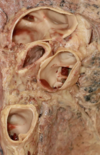CVS and Respiratory Anatomy Flashcards
(68 cards)
What is the lymphatic drainage of the breast?
- breast medial to the nipple drains through intercostal spaces to lymph nodes within the thorax (internal mammary lymph nodes)
- lateral breast drains to lymph nodes in the axilla

What forms the anterior axillary fold?
The pectoralis major
what nervs innervate the pectoral muscles
Pectoralis Major:
- Lateral and medial pectoral nerve
Pectoralis Minor
- Medial pectoral nerve
What innervates serratus anterior and why is this clinically relevalnt
- Long thoracic nerve
- Part of the function of SA is to hold the scapula against the ribcage
- if this muscle is paralysed you get ‘wing’
where is the cephalic vein and why is it clinically relevant
it’s where pacemakers are inserted through a catheter that is threaded through to the tip of the right atrium and SA node

What are the articulations of the clavicle
Medially with the menubrium of the sternum: sternoclavicular joint
Laterally with the acromion of the scapula: acromioclavicular joint
which ribs attach to serratus anterior
upper 8
what innervates all 3 layers of the intercostal muscles
intercostal nerves (T1-T11)
External intercostals - which direction do they run, and what is their action
- 11 pairs
- run inferiorly and mediall y
- they elevate the ribs increasing thoracic volume
Internal and Innermost intercostals
- run inferiorly and laterally
- they reduce thoracic volume by depressing the ribcage
what is the main role of the intercostal muscles
and what is the clinical relevance
contrct just enought so that they don’t get sucked in/blown out with negative and positive pressures of breathing
in some patients, the pressure needed to breathe overcome the intercostal muscles and you can obserce ‘intercostal recession’ which is an important sign of advanced resp distress
what can the LIMA sometimes be used for
coronary bypass because it runs so close to the LAD
Label structures in this Left Lung hilum


Label this Right Lung hilum


Label this lovely bit of heart


Label THIS lovely bit of heart


Label this third lovely bit of heart


LTLBOH


Does the phrenic nerve run anterior or posterior to the hilum of the lung?
Anterior
where does the left vagus branch to form the left recurrant laryngeal?
Under the arch of the aorta. The left recurrant laryngeal passes under the ligamentum arteriosum
What is the clinical significance of the nerve roots of the phrenic nerve?
painful stimulation of the diaphragm will be felt in the dermatomes supplied by the phrenic nerve nerve roots (C3, 4, and 5) this is typically in the side of neck and shoulder tip
Surfaces of the heart:
- Diaphragmatic: inferior
- Sterno-costal: anterior
- Base: posterior

What does the AVN recieve its blood supply from?
The posterior interventricular artery
What percentage of people have their posterior interventricular artery supplied by the left coronary, right coronary and how many by both?
- 90% supplied by the right coronary
- 30% supplied by the circumflex of the left coronary
- 20% supplied by arteries from each
i.e. 70% of people are right dominant, 10% of people are left dominant, 20% of people are codominant














